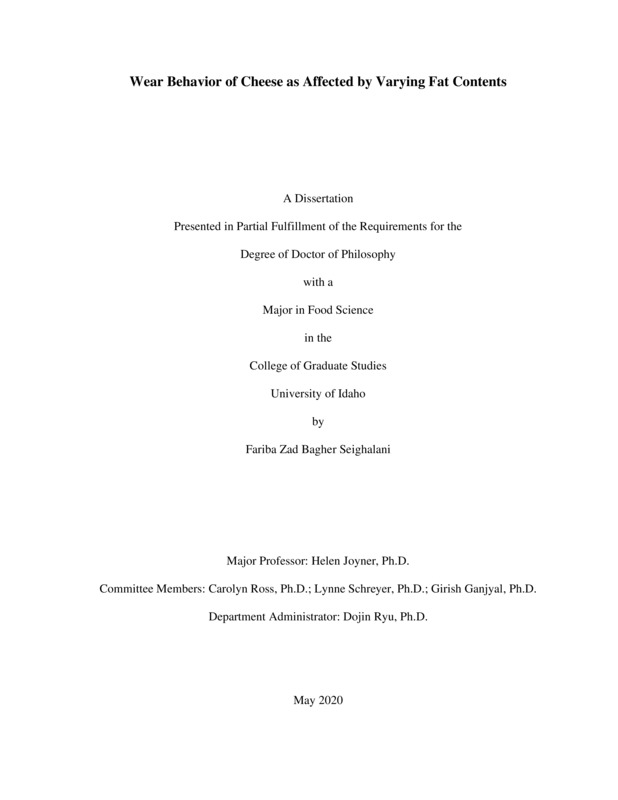Wear behavior of cheese as affected by varying fat contents
Zad Bagher Seighalnalaani, Fariba BAGHER. (2019-12). Wear behavior of cheese as affected by varying fat contents. Theses and Dissertations Collection, University of Idaho Library Digital Collections. https://www.lib.uidaho.edu/digital/etd/items/zadbagherseighalnalaani_idaho_0089e_11743.html
- Title:
- Wear behavior of cheese as affected by varying fat contents
- Author:
- Zad Bagher Seighalnalaani, Fariba BAGHER
- ORCID:
- https://orcid.org/0000-0002-9719-0108
- Date:
- 2019-12
- Embargo Remove Date:
- 2021-08-26
- Keywords:
- Cheese Rheology Sensory Tribology Wear behavior
- Program:
- Food Science
- Subject Category:
- Food science
- Abstract:
-
Cheese sliceability and shreddability are two main concerns for manufacturing palatable and functional cheese shreds and slices. However, processing behaviors may differ among cheeses with different fat contents because fat plays a crucial role in cheese texture. These differences may impact cheese processing behaviors. Wear testing and particularly mass loss measurements could be used as a quality control test to predict cheese processing behaviors as wear testing could imitate processing conditions which involve rubbing such as slicing and shredding. However, wear, a dimension of tribology, has been neglected in previous food tribology studies. Thus, the objectives of this project were to identify significant factors influencing cheese wear, determine the relationships among rheological, sensory, and wear behaviors, and develop a mathematical model to predict cheese mass loss. We started with preliminary work on two types of cheese: Monterey Jack and Cheddar. The two cheeses showed different wear and rheological behaviors, indicating cheese wear-rheology relationships. In the formal study, cheeses with 40, 50, 52, and 54% fat (dw) at different aging times (15, 30, 45, and 60 d) were evaluated. Wear measurements were performed using a rheometer equipped with a steel twin ball-on-disc system using a range of normal forces (0.5 and 0.7 N), sliding speeds (30 and 50 mm/s), and temperatures (5, 15, and 25°C). Penetration depth (mm) and friction coefficient were recorded, and mass loss was measured by calculating differences between sample weights before and after testing. A box plot model was created based on mass loss and expert classification of cheese processing abilities. Rheological tests, including large amplitude oscillatory shear (LAOS), strain sweeps at different temperatures (5, 15, and 25ºC) and frequencies (0.5, 5, and 50 rad/s), and large-strain compression at room temperature (22±2ºC), were used to measure cheese viscoelastic and fracture behaviors. Descriptive sensory analysis was used to evaluate cheese sensory texture attributes. To develop a wear model for cheese, mass loss and friction coefficient were used as the primary responses. Maximum strength derived from LAOS data was selected as a key rheological property for the model. Buckingham Pi theorem was used to find the relationship between the factors influencing wear behaviors and to construct the wear prediction model. Sensitivity analysis was conducted to determine the impact of each independent variable on mass loss. Mass loss was significantly affected by temperature, normal force, sliding speed, fat content, and aging time. Higher normal force resulted in significantly lower mass loss in all cheeses but C40 at 25°C, while penetration depth was higher at higher normal force. Mass loss values were significantly impacted at different temperatures at constant sliding speed and normal force. The highest mass loss was at 15ºC except for C40, mass loss was significantly lower at 5ºC and 25°C. However, penetration depth was significantly lower at 5ºC and increased at higher temperatures. Mass loss and penetration depth were more significant (lower p-value) at higher sliding speed and also increased as cheeses aged up to 60 d. Fat content, temperature, and aging time also had significant impact on cheese viscoelastic parameters. Higher temperature, aging time, and fat content led to lower rigidity and a greater extent of nonlinear viscoelastic behaviors in the cheeses. Mass loss was negatively correlated with critical strain, critical stress, complex modulus, and fracture stress, but was positively correlated with phase angle and fracture strain. Sensory data showed that texture attributes were affected by cheese fat content and aging time and were significantly correlated to mass loss at high normal force and sliding speed. The developed model showed a mean absolute error (MAE) of 0.001g, which considered small compared to the average value of mass loss from the cheese samples (approximately 0.102 g for an approximately 30 g sample), indicating good fit. Sensitivity analysis showed that mass loss was most influenced by normal force, followed by sliding speed, friction coefficient, and maximum strength. The results of this study provided valuable information for understanding wear behavior of cheese and its relationship with rheology and sensory. The findings of this project can help manufacturers improve and predict processing behaviors of cheese or similar food products.
- Description:
- doctoral, Ph.D., Food Science -- University of Idaho - College of Graduate Studies, 2019-12
- Major Professor:
- Joyner, Helen
- Defense Date:
- 2019-12
- Identifier:
- ZadBagherSeighalnalaani_idaho_0089E_11743
- Type:
- Text
- Format Original:
- Format:
- application/pdf
- Rights:
- In Copyright - Educational Use Permitted. For more information, please contact University of Idaho Library Special Collections and Archives Department at libspec@uidaho.edu.
- Standardized Rights:
- http://rightsstatements.org/vocab/InC-EDU/1.0/

